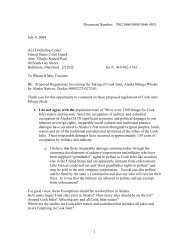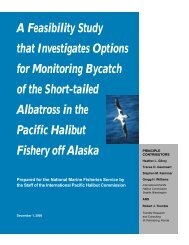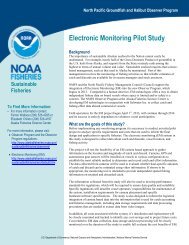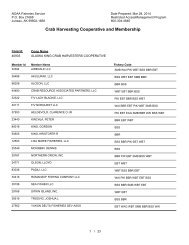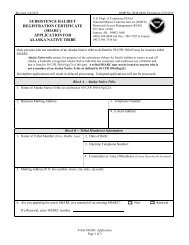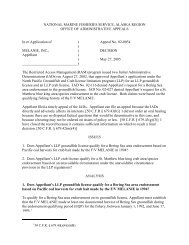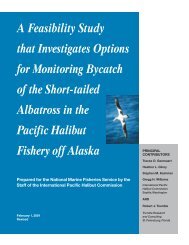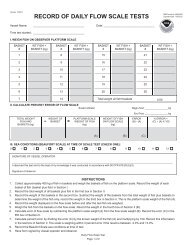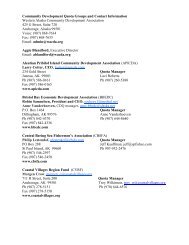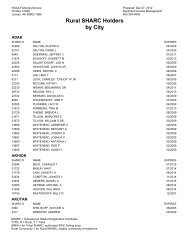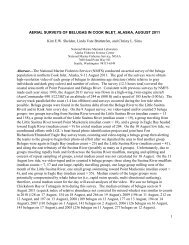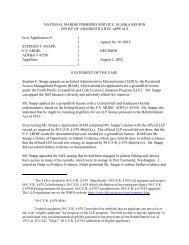Petition to List Lynn Canal Pacific Herring under the Endangered ...
Petition to List Lynn Canal Pacific Herring under the Endangered ...
Petition to List Lynn Canal Pacific Herring under the Endangered ...
Create successful ePaper yourself
Turn your PDF publications into a flip-book with our unique Google optimized e-Paper software.
<strong>to</strong>lerance optima. Locally differentiated selective pressures would consequently<br />
lead <strong>to</strong> selection against dispersal between spawning locations of differing salinity<br />
conditions, and may provide an adaptive explanation for <strong>the</strong> homing behavior<br />
reported in herring tagging studies (reviewed by McQuinn 1997).<br />
(Bekkevold et al. 2005).<br />
Fur<strong>the</strong>rmore, in contrast <strong>to</strong> o<strong>the</strong>r parts of <strong>the</strong> world, herring populations in <strong>the</strong><br />
eastern <strong>Pacific</strong>, from California <strong>to</strong> <strong>the</strong> Bering Sea, consist of a relatively large number of<br />
small populations (Hay et al. 2001b). These individual populations are locally adapted <strong>to</strong><br />
<strong>the</strong>ir spawning areas (S<strong>to</strong>kebury et al. 1999).<br />
The short term spatial variability in juvenile <strong>Pacific</strong> herring growth suggested that<br />
each bay was a unique nursery area and that <strong>the</strong> juveniles within <strong>the</strong>se bays were<br />
isolated. This differs from o<strong>the</strong>r research on herring life his<strong>to</strong>ry which suggests<br />
that <strong>the</strong>re is a great deal of mixing both in <strong>the</strong> nursery areas and feeding grounds<br />
while segregation occurs only during <strong>the</strong> spawning and early larva stages (Iles<br />
1971, Iles & Sinclair 1982, Sinclair et al. 1985). The physical and biological<br />
conditions within each bay appear <strong>to</strong> dictate <strong>the</strong> <strong>Pacific</strong> herring growth rate.<br />
(S<strong>to</strong>kesbury et al. 1999)(emphasis added).<br />
2. Significant Gap in Range<br />
The <strong>Lynn</strong> <strong>Canal</strong> <strong>Pacific</strong> <strong>Herring</strong> his<strong>to</strong>rically inhabited all of <strong>Lynn</strong> <strong>Canal</strong> and <strong>the</strong><br />
adjacent areas of Icy Strait and nor<strong>the</strong>rn Stephens Passage (See Figures 4 and 5). This<br />
area constitutes a significant portion of <strong>the</strong> range of <strong>the</strong> taxon, whe<strong>the</strong>r <strong>the</strong> taxon is<br />
identified as <strong>the</strong> species C. pallasi or <strong>the</strong> subspecies C. pallasi mirabilis.<br />
This petition considers <strong>the</strong> relevant taxon for this DPS significance fac<strong>to</strong>r <strong>to</strong> be a<br />
subspecies of <strong>the</strong> <strong>Pacific</strong> <strong>Herring</strong> and not <strong>the</strong> <strong>Pacific</strong> <strong>Herring</strong> species as a whole. As<br />
discussed earlier, Grant and Utter (1984) indicated: 1) an eastern North <strong>Pacific</strong><br />
subspecies of <strong>Pacific</strong> <strong>Herring</strong>, C. p. mirabilis, is described for <strong>the</strong> area from <strong>the</strong> Bering<br />
Sea <strong>to</strong> California (See Figure 3), and 2) <strong>the</strong> Bering Sea herring are genetically<br />
distinguished from rest of <strong>the</strong> herring <strong>to</strong> <strong>the</strong> south in North America, possibly dividing C.<br />
p. mirabilis in<strong>to</strong> at least two races or subspecies. Therefore, this petition concludes that<br />
<strong>the</strong> range of <strong>the</strong> taxon may include: 1) <strong>the</strong> area from <strong>the</strong> Bering Sea <strong>to</strong> California, or 2)<br />
<strong>the</strong> area from <strong>the</strong> Gulf of Alaska <strong>to</strong> California, or 3) a smaller area in <strong>the</strong>nor<strong>the</strong>rn Gulf of<br />
Alaska.<br />
There is no specific number or percentage required by <strong>the</strong> DPS Policy in<br />
determining what is a significant gap in a species’ range. Based on <strong>the</strong> overall<br />
importance of herring <strong>to</strong> <strong>the</strong> ecosystem, <strong>the</strong> adaptive potential of each herring population,<br />
and <strong>the</strong> uncertain taxonomy of <strong>Pacific</strong> <strong>Herring</strong>, <strong>the</strong> area his<strong>to</strong>rically occupied by <strong>Lynn</strong><br />
<strong>Canal</strong> <strong>Herring</strong> qualifies as a significant gap in <strong>the</strong> range of <strong>the</strong> taxon.<br />
27



